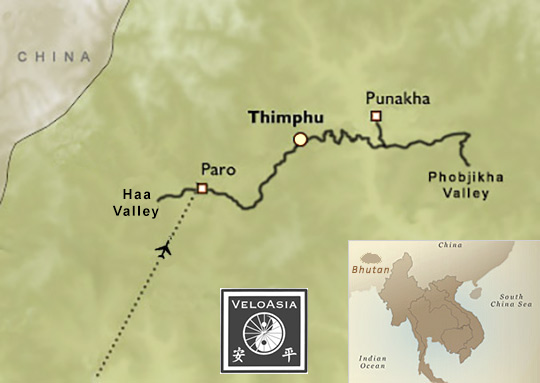
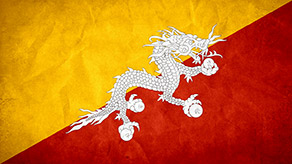
Trip Details
Bhutan Bicycling Tour From 7-14 Days/Nights Intermediate Hiking & Cycling
Fair Condition Roads
Land cost: from US$5,880
Departure Point: Bangkok
Trip Dates
Custom Tour March-May, & Sept-October
Bhutan Cycling Tour Itinerary
Bhutan is as spectacular and fascinating off as it on the bike. Much like the other places we organize trips in, we'll plan insightful, immersive and extraordinary experiences that reveal the real Land of the Thunder Dragon, from the people-to-people encounters, activities such as archery, and attending any of the renowned tsechus (festivals) that fall around your dates.
After arrival into Paro's high altitude airport in the Kingdom of Bhutan (“Edge of the Earth”), clear customs and immigration,* and meet escort to transfer into Paro for lunch orientation at the famed Sonam Trophel Restaurant. Afterwards, briefly strolling around downtown Paro and an optional visit to the National Museum of Bhutan located in the watch tower of Ta Dzong. The museum is home to a variety of Thangka art canvases, Buddhist relics, Paro artifacts and rare stamps. The museum is ideal for those who want to learn about the history and culture, but also a perfect place to visit this acclimation day with no strenuous activities planned this day. Time permitting, also visiting Rinpung Dzong, the seat of provincial administration and a monastic school. In the early evening, enjoying a sampling of local cuisine during an orientation dinner with your guide.
For those impatient to pedal, we can enjoy a short evening ride along the Pa Chu River to Drugyel Dzong (the Ruined Fort).
*Visa required in advance of arrival for entry into the Kingdom of Bhutan (Druk Airlines will have a copy of your visa, please carry a copy of visa approval letter). Tickets to Paro, Bhutan, are paper tickets (Druk Air has not adopted e-tickets yet) and will be delivered to your Bangkok hotel or will be held will-call at the Druk Air check-in counter on the day of your flight. Simply ask for them at check-in. This is a very small airline with only a couple of flights a day, so they will know who you are.
Druk Air Flight 123, Depart Bangkok 5:50 AM, Arrive Paro at 9:30 AM
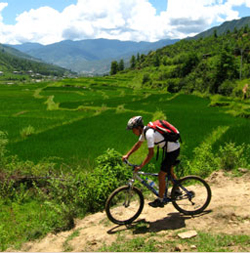 Paro Valley
Paro Valley
Today's morning ride will be easy, allowing acclimizing to the higher elevation, and will cover all the main highlights of the Paro Valley and off-the-beaten-track riding through a little visited side valley. Sweeping down to the valley floor, we'll follow the Pa Chhu (river) via a traditional covered bridge (Nyamai Zam) and then past the main archery ground, Ugyen Pelri Palace and into Paro town. Then cycling off road at Dob Shari alongside the Do Chhu past several temples and traditional farmhouses climbing very gradually up to the village of Dobshaptoe.
Having negotiated the narrow lanes return to Paro via a higher track rejoining the tarmac to pay our respects at Kyichu Lhakhang one of the oldest temples in Bhutan with its magic orange tree that bears fruit all year round. Continuing up the valley (either by road or on tracks) with Taktsang Goemba (Tiger’s Nest Monastery) perched above wind through villages, rice paddies and pine forest to the road head (next stop Tibet) and archery ground at Drukgyel Dzong, built in 1644 by Zabdrung Ngawang Namgyal to control northern route to Tibet. Now its time to enjoy a freewheel virtually all the way back to Paro via Rinpung Dzong – ‘Fortress on a Heap of Jewels’, before the challenging climb back to Uma Paro (support vehicle is with us to assist with the last leg if necessary) (B,L)
Today 3-7 hours of cycling is planned to be easy to moderate, riding for a maximum of 50 kilometers, mostly flat with gradual ascents and descents on about 1/3rd road and 2/3rds graded tracks and trails.
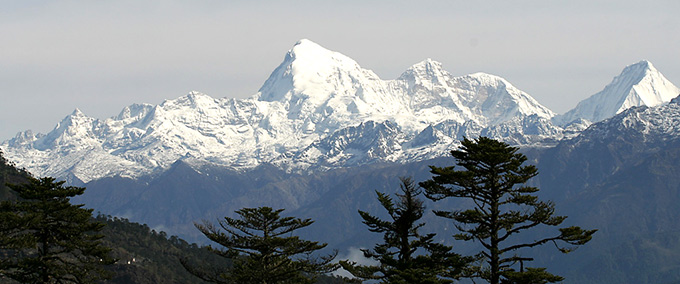
Today we start early (by van or bike) for rural Haa Valley by way of the spectacular Chele La Pass which at 3,810 meters (12,500 feet), is the highest road pass in Bhutan. The climb from Paro snakes upwards through blue pine and rhododendron forests for 21 miles (35 kilometers)on an empty road . On a clear day we'll view Bhutan’s highest peak, the sacred Mount Jhomolhari, towering in the distance at over 7,000 meters (nearly 24,000 feet).
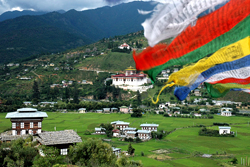
After reaching the pass we'll pay respect to elders, as is the Bhutanese custom, and admire the surrounding Himalayan views, and if we've ridding for long, break for refreshment before cycling past the hundreds of colorful prayer flags and enjoying a long, winding descent through the pines into the remote and untouched Haa Valley, with a sparse population and very few tourists.
On entering the valley, we'll see the Wangchulo Dzong, and continue on the flat road along the Haa river to the tiny Haa township. In the afternoon, strolling around Haa before dinner.
It's all up and down today and entirely on the main, paved road, and one of the trips most enjoyable rides. We can begin cycling at any point on the 21-mile climb to the Chele La Pass. The entire gradual but challenging 21-mile climb up to Chele La Pass can be added this day with 1,700 meters (5,500 feet) of climbing. The descent from Chele La is 15 miles of sharper switchbacks, flattening on the reaches into the town of Haa.

Itinerary options: for trips of shorter length, we can return to Paro today, looping around 79 kilometers from Paro to view Chuzom (river confluence), then return to Uma Paro by van or return over Chela La and enjoy another long descent (35 kilometers) into Paro.
The Haa Valley, only opened to travelers in 2002, is one of the most unspoiled and untouched in the country— the ideal place to see into the country's past and worthy of a day to linger in the sublime setting.
This morning, we'll take a short ride to visit the temple Tachu Gompa visit the monastery, Lhakhang Karpo (the White Temple), visiting and sharing time with the young novice monks here.
After breakfast, before departing towards Thimphu (46miles - 1 ½ hrs). Sights along the route include a 15th century Tamchog Temple, ancient Buddhist Stupas and a 17th century fortress, Semtokha Dzong. With a population over 45,000, Thimphu is like no other capital city; set in a unique valley, with distinctive architecture reflective of the harmony of tradition and modernity. A city with no traffic lights where police still direct traffic at intersections, yet it is the largest city in the country and seat of the government as well as the main hub of commerce.
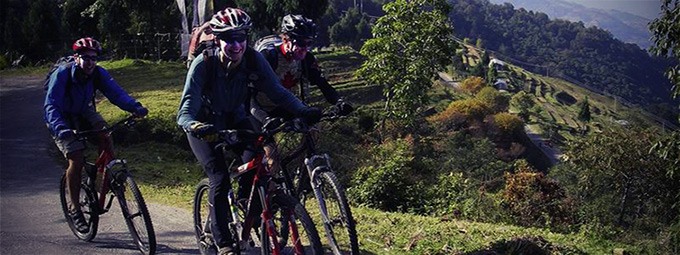
Exploration of Thumphu's main cultural and historical attractions, including Institute of Traditional Medicine, School of Traditional Arts and Crafts, Folk Heritage and Textile Museums, and the Jungshina Handmade Paper Factory (Bhutan in ancient days was the biggest supplier of paper in the Himalayan region for printing religious scriptures and prayers). Next drive a short distance to the Sangaygang hill shrouded in hundreds of colorful flags with a great view over the capital city. Walk a short distance from here to the National Animal Sanctuary to see the unique Takin, the national animal. On the way back the bus will stop at the National Emporium. (B,L)
Today's 74 miles (114 kilometers) is one of the Bhutan's most beautiful, passing the scenic overlook of where the Paro and Thimpu rivers unite, then rolling along the winding road through the valley. The road busies at the junction of the rivers and the remaining 21 miles (33 kilometers), we will travel by van to the capital). Today's only real climb is, a four-mile ascent near mile 36 (and where after the river confluence, below).

With a population just over 50,000, Thimphu is small and like no other capital city; set in a unique valley, with distinctive architecture reflective of the harmony of tradition and modernity. The capital Thimphu itself sprawls up the wooded western hillside of the Wang Chhu and is the center of government, but also religion and commerce. A city with no traffic lights where police still direct traffic at intersections, yet it is the largest city in the country and seat of the government as well as the main hub of commerce.
Today, we'll stretch our legs and with a morning hike into the forested foothills of the Thimphu Valley, ascending to Cheri Goemba Monastery (built in 1620), with expansive views over the valley's river, farms, and pine forests. We'll continued hiking through the pines, pausing in local villages and farms along the way and breaking for lunch with a farmer and his family.
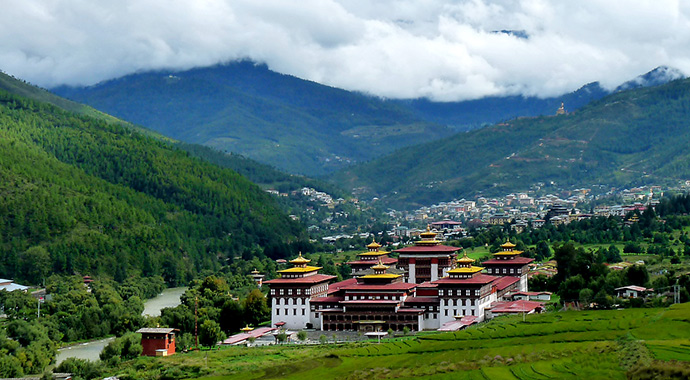
In the afternoon, easy cycling around the valley until the afternoon, visting the massive Tashichoe Dzong. In the evening, strolling the alleys of the the capital. In the evening the National Memorial Chorten is a nice place to observe how the locals recite prayers at dusk. The stupa was built in 1974 in memory of the third king of Bhutan.
If it is the weekend during your visit, we will explore the local market where locals gather to sell their vegetables, traditional masks, textiles, incense, and jewelry. The market is one of the best place in Bhutan to buy traditional crafts.T here is often an archery competition taking place nearby we can watch.
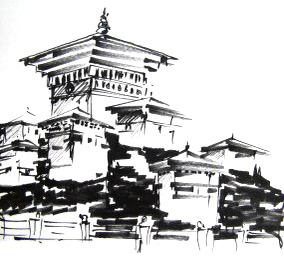
The first thing that strikes you after arrival in Bhutan is the dress that everyone around is wearing. The colorful dress of the men is called the 'gho' which is something similar to the Scottish kilt. With length up to the knee, and the upper part of the dress wraps around the body and loosened as per the size & fitting. There are many pockets in the inside but its still surprising how much can be stored in these pockets. The women wear the kiras which are full length unstitched garments fastened at the shoulders by two hook like clips called komas and a waistband which is also of a similar cloth. Added to this is a blouse and a jacket which completes the dress. The range of colors is varied and the dress material fine. By law, and custom, every government worker, every teacher and almost everyone holding public office has to wear the traditional dress. Even school uniforms conform to this dress code.
You'll soon no doubt notice that this same uniformity spills over into architecture; every building has to have the basic traditional form. This is mandated by law so there are no "modern" looking buildings. There is a degree of uniformity and tradition that shows through.
After breakfast we depart for the Punakha Valley 51 miles away, climbing up over over the 10,300 foot (3,139 meter) Dochu La Pass. Ascending out of Thimphu valley we'll view Semtokha Dzong the giant Buddha atop the Kuensel Phodrang hill on the opposite side of the valley. If it's a clear day, the whole range of inner Himalayan peaks can be viewed, including the highest unclimbed mountain in the world, Gangkhar Puensum at 7,541 meters.
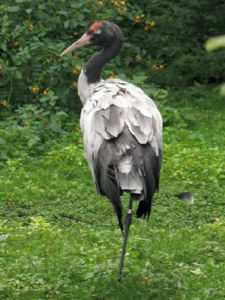
From Dochu La, the road descends through a rich forest, blooming giant magnolias, fields of rhododendrons and many other flowers during the right season. After, continue descending into valleys of Punakha and Wangdue (the valley is a paradise for bird watchers). We'll stop our bikes here for lunch and visit a rustic fortress then reaching the flats along the Punakha river and continue past Wangdue town, through dense forests of oaks, rhododendrons and other evergreen forests of Black Mountain Range to Punakha.
Punakha, the former capital of Bhutan until 1955, is a picturesque town surrounded with snow capped Himalayan slopes known for the massive Punakha Dzong. Known in ancient times as the Druk Pungthang Dechhen Phrodang or “the palace of great happiness”, the Punakha Dzong was the second dzong to be built in Bhutan. The fortress-monastery was built in 1637 by Shabdung Nawang Namgyal in a commanding position at the confluence of the Po Chhu and Mo Chhu (Father and Mother rivers). It once served as the seat of the Kingdom's government and is now the winter home of Je Khempo, the head abbot of Bhutan, along with a retinue of about 1,000 monks.
After hotel check-in, followed by a short rest in the hotel, enjoying a short hike of about one hour through local farms and villages to the monastery, Chimi Lhakhang. The site was built in 1499 by the 14th Drukpa hierarch, Ngawang Choegyel, after the site was blessed by the "Divine Madman" the maverick saint Drukpa Kinley (1455–1529) whose legacy was many legends for his unorthodox ways of teaching Buddhism by singing, humor, and outrageous behavior, often bizarre, shocking, and with sexual overtones (Drukpa Kuenley is one of the most revered and followed saints in Bhutan, and his symbol – the phallus – will be noticed in various forms within Bhutanese houses and restaurants. One of the most odd aspects of the temples is its place as a pilgrimage site for women who come seeking blessings for children and will receive a thump on the head by the presiding Lama with a 10-inch ivory, wood, and bone phallus as well as the bow and arrow supposedly used by the Divine Madman himself. After refreshing tea at the temples teahouse, return to town for dinner.
The ride up to Dochu La is gradual through the ubiquotous pine forests, and like our ride to Haa Valley, this day is mostly an all up and down endeavor, with over 5,000 feet of climbing coming at the beginning of the ride followed by a magnificent descent through the forest.
After breakfast we depart for the Punakha Valley 51 miles away, climbing up over over the 10,300 foot (3,139 meter) Dochu La Pass. Ascending out of Thimphu valley we'll view Semtokha Dzong the giant Buddha atop the Kuensel Phodrang hill on the opposite side of the valley. If it's a clear day, the whole range of inner Himalayan peaks can be viewed, including the highest unclimbed mountain in the world, Gangkhar Puensum at 7,541 meters.
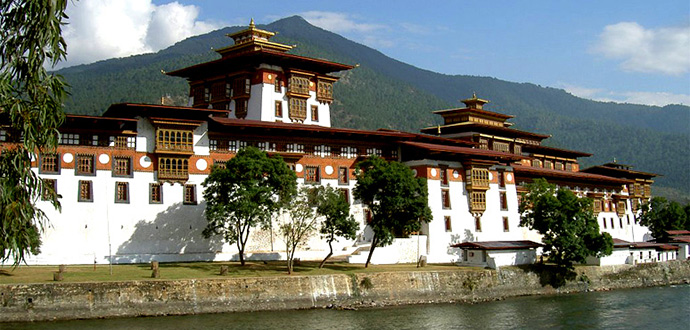
This morning visiting Bhutan's most recognized temple after the Tiger's Nest, the Punakha Dzong, one of the most beautiful Dzongs in the country. "Punthang Dechen Phodrang" (The Palace of Great Bliss) was built in 1637 by the Zhabdrung as a war fortress. Today, it is the second oldest and second largest dzong in Bhutan and the dzong showcases the finest examples of Bhutanese arts and crafts along its walls and interiors. Of special interest is the Kuenrey, a temple at the far end of the Dzong with awe-inspiring giant statues of the Buddha, flanked by the Guru and the Zhabdrung, and a ceiling of hundreds of beautifully painted dragons adorning it. Here are also the most beautiful paintings of the 12 episodes of the life of the Buddha (Zedpa Chuni).
Afterwards, we'll cycle or drive out of Punakha the ten miles (16 kilometers) along the flat riverside road to Wangdue, then turn uphill on a quiet side road heading up towards the Pele La Pass (10,800 ft.), to the broad glacial and alpine valley of Phobjikha. Phobjikha is home of the only monastery of the Nyingma tradition of Buddhism in western Bhutan and famous for the endangered black-necked cranes from Tibet that winter here (the birds arrive near the end of August). With beautiful scenery of rhododendrons, dwarf bamboos and villages, ideal for long walks it embodies the serenity and beauty of rural life in Bhutan.
After arriving at the Lawa Pass (not yet the Pele Pass, which comes tomorrow), descending into the Phobjikha Valley and the small remote town of Gantey. In the afternoon, walking the town and through the scenic foothills.
The ride to Phobjikha is all uphill, gaining a leg straining 1,500 meters, with a slight descent into Phobjikha. From Wangdue to Phobjikha is 46 miles (77 kilometers).

Following breakfast, we'll depart by van, or bikes, backtracking the six miles back up to the Lawa Pass, then heading steeply up the short route to 3,300 meter Pele Pass. From Pele Pass we descends into the Longte Valley and within another ten miles, passing Chendebji Chorten, a stone Buddhist monument, and the small village of Chendebji. Upon reaching Trongsa, we will brak for lunch, briefly explore the town and visit the fortress, Trongsa Dzong which dominates the entire vista of the town, stretching across a ridge. Initially built in 1648 and expanded in later years, it was the seat of the most powerful governor in the country with influences that stretched all the way to east. Both the first and second King ruled the country from this ancient dzong.
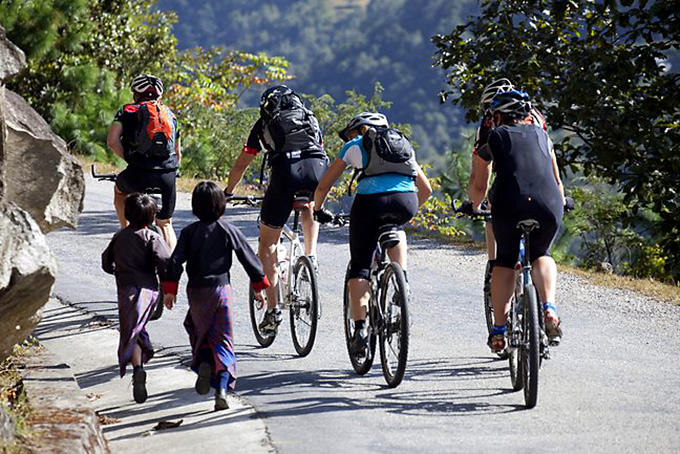
Afetr lunch, cycling the roughly forty miles to Bumthang will take us into a different ecological region of immense beauty, riding through confers and lush alpine vegetation, affording sublime views to savor if not for having to bike up the 21 or so difficult miles of the Yotong Pass reaching 3,400 meters (we can always van this part).
Bumthang is a general name given to combination of four valleys: Chumey, Choekhor, Tang and Ura. The four valleys that make Bumthang is the sacred heart of the country and is home to many prominent Buddhist temples and monasteries. Besides natural beauty the valley is bountifully blessed with numerous ancient temples and is the revered birthplace of many saints. It was here that the legendary saint Pema Lingpa was born, to whom the Bhutanese Royalties trace their lineage. Bumthang is also distinguished in history as the first place in Bhutan where Guru Rimpoche brought Buddhism.
Before reaching Bumthang, we'll stop to visit a weaving center in Chumey valley at a. Textiles in Bhutan are unique in style to each region, and Bumthang is famous for woolen textiles called Yathra and Mathra. From here to Chamkhar valley, is only a half hour away and we'll continue biking into town.
We climb this morning for about ten miles, over the Pele Pass.

From lunch in Trongsa to our destination, Jakar, is 46 miles (77 kilometers), crossing over the grueling Yotong Pass, a steep continuous climb of 21 miles (33 kilometers). The descent into Bumthang is a breathtaking 18 mile stretch (30 kilometers).

Biking and trekking today in the sacred Bumthang Valley. Bumthang consists of four valleys and is the heart of both the religious and political history of the country. Today, visiting Jakar Dzong, a 26th fortress monastery which continues to be the seat of local government and monastery. Afterwards, exploring of Jambey Lhakhang, one of the two 7th century temple in the country (other being Kyichu in Paro to be visited later). They are two surviving temples out of supposedly eight in Bhutan commissioned by King Songtsen Gampo of Tibet who took upon himself to build 108 temples in Tibet and other Himalayan regions.
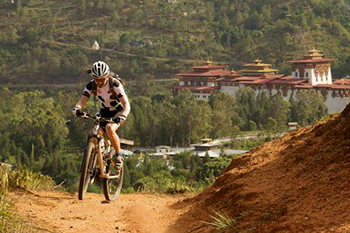
It was here that Guru Rimpoche conducted his first sermon on Tantric Buddhism for his host King Sendha, the local ruler, his family and subjects. Kurjey Lhakhang complex. It consists of three temples. The one on the right was built in 1652 on the rack face where Guru meditated in the 8th century. The body imprint of the great master can be distinctly seen in the rock cave enshrined in the temple. Tamshing Lhakhang, located in a village across the river from Kurjey Lhakhang which is the seat of Bumthang’s famous son saint Pema Lingpa who built it himself in 1501. A skilled tantric master and an artist he sculpted the main statues and painted the frescoes, which can be seen even today, mostly in original state.
Konchosum Lhakhang also located here, is an old temple suspected to be from the 6th or 7th century but the current structure dates back to the same period as Tamshing Lhakhang. It is also a site from where Terton Pema Lingpa discovered sacred treasures. There is a bell in the temple, which when rung was believed to be heard as far as Lhasa, Tibet.
This morning relaxing and savoring our final moments in remote Bhutan. Mid-morning we fly back to Paro on a short hop. After arrival, transfer into Paro to further explore the town or relax before tomorrow's trek.
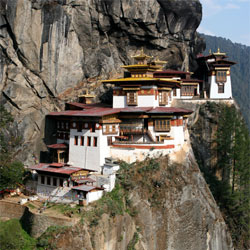
Early this morning, hiking to famous Taktsang known as the “tiger's nest monastery” — Taktsang — an image recognized around the world. Hiking to the monastery viewpoint (about one hour, two to actually visit the temple).
Returning after lunch, visit Drugyel Dzong in the northern valley and 8th century Kyichu temple. Time permitting, visit to Punakha Dzong before departure for Paro. Farewell dinner with guide. Accommodation: Zhiwaling. (B,L)
Transfer with guide, who will bid you farewell at the gates of Paro airport. Depart Paro to Kathmandu on Druk Airlines Flight KB 204 Departing 10:00 am, Arriving 10:45 am. After arrival transfer on own to hotel.
We can arrange a half day cycling in the foothills of Kayhmandu today, followed by an afternoon exploring highlights of the town, including local markets, Patan Durbar Square, Krishna Temple and driving to the Swayambhu Stupa for panoramic views of Kathmandu.
After breakfast, transfer to airport for flight to New Delhi. on Druk Air flight KB 204 Departing 11:25AM, Arriving Delhi at 12:40PM (Duration 1hr 30min).
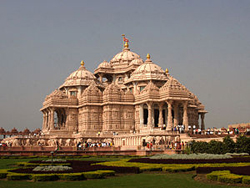 Akshardham Temple
Akshardham Temple
Free sightseeing in New Delhi, the capital city of India and former political and financial center of several empires of ancient and medieval India, most notably of the Mughal Empire and later the seat of power for the British Raj. Recommended day: Begin with exploration of the monumental Akshardham Temple, a large and elaborate Hindu temple carved of red sandstone consecrated only in 2005. Sitting on the banks of the Yamuna River, the cavernous complex features a large monument, crafted entirely of stone (right). After lunch, continued sightseeing in the new city, including markets, museums and attractions until late afternoon. Car and driver on-call for dining outside of hotel. (B)
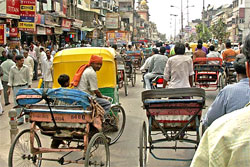 Old Delhi
Old Delhi
Morning tour of Old Delhi, the capital of Muslim India between the 12th and 19th centuries, and regarded as one of the oldest existing cities in the world, estimated to be over 5000 years old. Begin exploration with a rickshaw ride through bustling Chandini Chowk, India's most prominent wholesale and retail markets. Afterwards, visit the Red Fort, symbol of New Delhi constructed 1639. Art work in the Fort is a synthesis of Persian, European and Indian art which resulted in the development of the unique Shahjahani style. Following lunch, board afternoon flight to Agra. On arrival transfer to the Amarvilas Resort and Spa. Evening visit the Taj Mahal at sunset.
Accommodation: Oberoi Amarvilas Resort
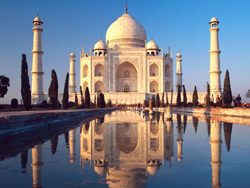
Early morning visit the Taj Mahal to witness the golden light bask the temple at sunrise. After breakfast, exploration of Agra Fort overlooking the Yamuna River. Time permitting, exploration of Sikandra, the mausoleum of Emperor Akbar or transfer outside Agra to explore World Heritage Site Fatehpur Sikri, a majestic fort and abandoned ghost city. Afternoon city tour time permitting, followed by evening return flight to Delhi.
After breakfast, depart Delhi to Bangkok . After arrival, transit to international flight.
QUESTIONS? Call us in San Francisco at or Email us. We are happy to answer questions or inquiries.
